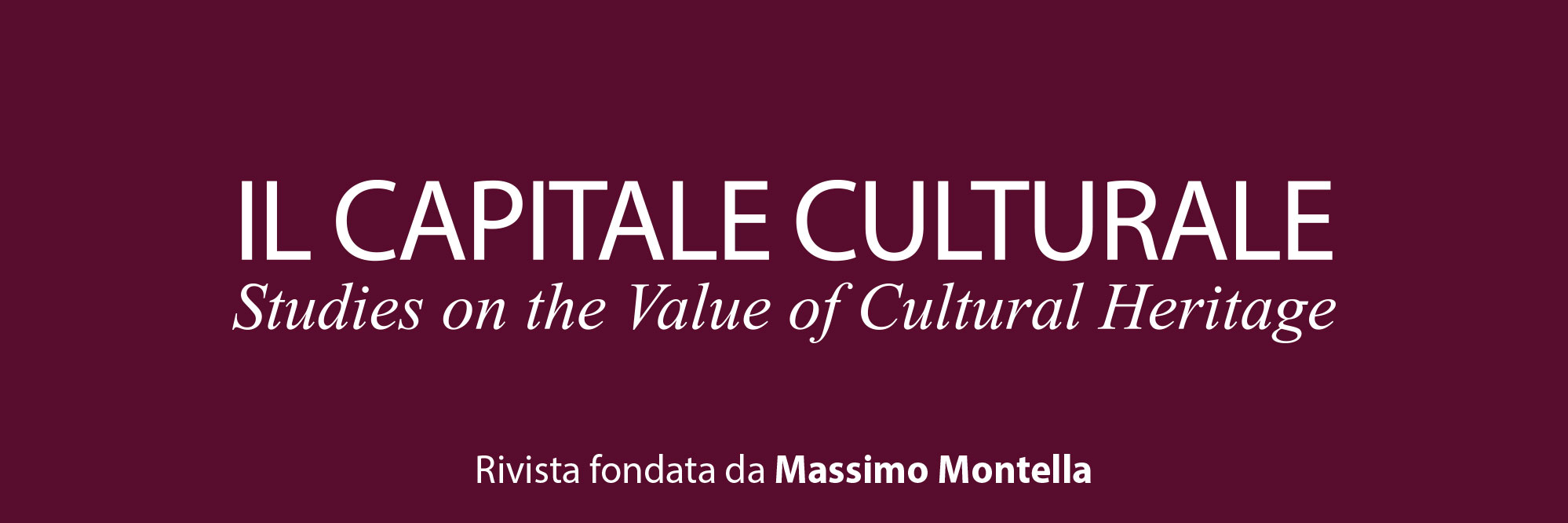Weaving Myths: Ovid’s Metamorphoses and the Labours of Hercules Tapestries in the Renaissance
Downloads
Pubblicato
Fascicolo
Sezione
Licenza
Tutti i materiali pubblicati sono coperti da copyright, mantenuto dall'Università di Macerata che ne supporta finanziariamente e tecnicamente la pubblicazione.
La licenza adottata è la Creative Commons - Attribuzione/Condividi allo stesso modo. Ovvero, gli autori che pubblicano su questa rivista accettano le seguenti condizioni:
- Gli autori mantengono i diritti sulla loro opera e cedono alla rivista il diritto di prima pubblicazione dell'opera, contemporaneamente licenziata sotto una Licenza Creative Commons - Attribuzione che permette ad altri di condividere l'opera indicando la paternità intellettuale e la prima pubblicazione su questa rivista.
- Gli autori possono aderire ad altri accordi di licenza non esclusiva per la distribuzione della versione dell'opera pubblicata (es. depositarla in un archivio istituzionale o pubblicarla in una monografia), a patto di indicare che la prima pubblicazione è avvenuta su questa rivista.
- Gli autori possono diffondere la loro opera online (es. in repository istituzionali o nel loro sito web) prima e durante il processo di submission, poiché può portare a scambi produttivi e aumentare le citazioni dell'opera pubblicata.
DOI:
https://doi.org/10.13138/2039-2362/3250Abstract
The Labours of Hercules was a particularly prolific motif for tapestries in the Renaissance. The iconographic scheme of the Hercules series synthesized an enormous range of ancient and medieval philosophical and didactic erudition. This paper will examine an episode especially favoured in the sixteenth-century series: the fight between Hercules and the river-God Achelous (Metamorphoses, IX, 1-100). In scholarly literature, the scene has often been interpreted as the battle of Hercules against the Cretan bull. However, this episode was widely superseded by Hercules’ struggle against Achelous, due to the authority of Ovid’s texts. It will delve deeper in the matter by focusing on a curious detail: all tapestries depict Achelous with a human body and a bull’s head. This finding provides valuable new insights regarding this idiosyncratic and complex iconography.Riferimenti bibliografici
Allan A., Anagnostou-Laoutides E., Stafford E., edited by (2020), Herakles Inside and Outside the Church: from the first Apologists to the Quattrocento, Leyden: Brill.
Amielle G. (1995), Les Métamorphoses illustrées en France au XVIe siècle, in Metamorphosen des Ovid in der Neuzeit. Der antike Mythos in Text und Bild, edited by H. Walter and H.-J. Horn, Berlin: Mann, 1995, pp. 79-84.
Arnold P. (1997), Die Taten des Herkules und andere Steinbildwerke der Landshuter Stadtresidenz, Landshut: Hans-Leinberger-Verein.
Berchorius P., Reductorium morale, Liber xv: Ovidius Moralizatus, cap. II-XV. Ovidius moralizatus’ naar de Parijse druk van 1509, edited by J. Engels (1962), Utrecht: Rijksuniversiteit.
Biancardi S., Deleville P., Montorsi F., Possamaï-Pérez M., edited by (2018), Ovidius explanatus. Traduire et commenter les Métamorphoses au Moyen Âge, Paris: Garnier.
Boccaccio G., Genealogie deorum gentilium libri, edited by V. Romano (1951), 2 vols., Bari: Laterza.
Bouquet M., Méniel B., edited by (2011), Servius et sa réception de l'Antiquité à la Renaissance, Rennes: PUR.
Buchanan I. (1994), Michiel de Bos and the Tapestries of the Labours of Hercules after Frans Floris (c. 1565). New Documentation on the Tapestry Maker and the Commission, «Revue Belge d’Archéologie et d’Histoire de l’Art», 63, pp. 37-62.
Buchanan I. (2015), Habsburg Tapestries, Turnhout: Brepols.
Bücken V., De Meûter I., edited by (2019), Bernard van Orley, Brussels: Bozar.
Bull M. (2006), The Mirror of the Gods. Classical Mythology in Renaissance Art, London: Penguin.
Campbell T., edited by (2002), Tapestry in the Renaissance. Art and Magnificence, New York: MET.
Campbell T. (2007), Henry VIII and the Art of Majesty. Tapestries at the Tudor Court, New Haven: Yale University Press, 2007.
Capriotti G. (2020), Ovid’s Hercules in 1497: a Greek Hero in the Translation of the Metamorphoses by Giovanni Bonsignori and in His Woodcuts, in Herakles Inside and Outside the Church: from the first Apologists to the Quattrocento, edited by A. Allan, E. Anagnostou-Laoutides, E. Stafford, Leyden: Brill, pp. 271-290.
Cerrito S. (2011), A propos de la Bible des Poëtes, «Le Moyen Français», 69, pp. 1-14.
Clark J., Coulson F., McKinley K., edited by (2011), Ovid in the Middle Ages, Cambridge: Cambridge University Press.
Cohen-Skalli A., Marcotte D. (2015), Poggio Bracciolini, la traduction de Diodore et ses sources manuscrites, «Medioevo Greco», 15, pp. 63-107.
Coulson F., Roy B., edited by (2000), Incipitarium Ovidianum. A Finding Guide for Texts Related to the Study of Ovid in the Middle Ages and Renaissance, Turnhout: Brepols.
Courcelle P. (1967), La Consolation de Philosophie dans la tradition littéraire. Antécédents et postérité de Boèce, Paris: Études augustiniennes.
Demats P. (1973), Fabula. Trois études de mythographie antique et médiévale, Geneva: Droz.
Dulac L. (2002), Le chevalier Hercule de l’Ovide moralisé au Livre de la mutacion de fortune de Christine de Pizan, «Cahiers de recherches médiévales», 9, <http://crm.revues.org/68>, 05/06/2023.
Ettlinger L. (1972), Hercules Florentinus, «Mitteilungen des Kunsthistorischen Institutes in Florenz», 16, pp. 119-142.
Ferrandis J. (1943), Datos documentales inéditos para la historia del arte español. 3: Inventarios reales (Juan II a Juana la Loca), Madrid: Consejo superior de investigaciones científicas.
Harf-Lancner L., Mathey-Maille L., Szkilnik M., edited by (2009), Ovide métamorphosé. Les lecteurs médiévaux d’Ovide, Paris: Presses Sorbone.
Jung M.-R. (1966), Hercule dans la littérature française du XVIe siècle. De l’Hercule Courtois à l’Hercule baroque, Geneva: Droz.
Jung M.-R. (2002), Hercule dans les textes du Moyen Âge: essai d’une typologie, in Rinascite di Ercole. Convegno internazionale. Verona, 29 maggio-1 giugno 2002. Atti, edited by A.M. Babbi, Verona: Fiorini, pp. 9-69.
Junquera P. (1974), Los trabajos de Hércules. Una serie inédita de tapices del Patrimonio Nacional, «Reales sitios», 42, pp. 18-24.
Junquera de Vega P., Herrero Carretero C. (1986), Catalogo de tapices del Patrimonio Nacional. Siglo XVI, vol. 1, Madrid: Patrimonio Nacional.
Karafel L. (2016), Raphael’s Tapestries. The Grotesques of Leo X, New Haven: Yale University Press.
Lafond M. (2016), La figure d’Hercule dans les commentaires de Servius, in Fragments d’érudition. Servius et le savoir antique, edited by A. Garcea, M.-K. Lhommé, D. Vallat. Hildesheim: Olms, pp. 465-478.
Laruelle A.-S. (2019), La figure d’Hercule dans l’art de la tapisserie à la Renaissance (c. 1450-1565). Fortune iconographique et usages politiques, Ph.D. dissertation. Université de Liège. (Book forthcoming).
Laruelle A.-S. (2020a), Hercules in the Art of Flemish Tapestry (1450-1565), in The Exemplary Hercules. From the Renaissance to the Enlightenment and Beyond, edited by V. Mainz, E. Stafford. Leiden: Brill, pp. 97-118.
Laruelle A.-S. (2020b), A New Perspective on Mary of Hungary’s Labours of Hercules Tapestries (Patrimonio Nacional, series 23), in Art, Power and Gender. Mary of Hungary and Female Patronage in the Renaissance, edited by N. Garcia Perez. Turnhout: Brepols, pp. 123-134.
Lenz O. (1924), Über den ikonographischen Zusammenhang und die literarische Grundlage einiger Herkuleszyklen des 16. Jahrhunderts und zur Deutung des Dürerstiches B. 73, «Münchner Jahrbuch der bildenden Kunst», 1, pp. 80-103.
Moisan J.-Cl., Vervacke S. (2003), Les Métamorphoses et le monde de l’imprimé : la Bible des poëtes, Bruges, Colard Mansion, 1484, in Lectures d’Ovide, publiées à la mémoire de Jean-Pierre Néraudau, edited by E. Bury. Paris: Belles Lettres, pp. 217-237.
Morte Garcia C. (2012), La colección de tapices de la Universidad de Zaragoza, in Renacimiento y Barroco en las Colecciones de la Universidad de Zaragoza, edited by C. Lomba Serrano, J.C. Lozano Lopez. Zaragoza: Universidad, pp. 40-75.
Moss A. (1982), Ovid in Renaissance France. A Survey of the Latin Editions of Ovid and Commentaries printed in France before 1600, London: Warburg Institute.
Ovide Moralisé. Poème du commencement du XIVe siècle, edited by C. De Boer (1915-1938), 5 vols., Amsterdam: Müller.
Pauli G. (1908), Dürers Zeichnungen der Herkulestaten im Kupferstichkabinet der Kunsthalle, «Jahrbuch der bremischen Sammlungen», 1, pp. 69-72 and pl. XV-XVII.
Possamaï-Pérez M. (2006), L’Ovide moralisé. Essai d’interprétation, Paris: Champion.
Scaglia G. (2000), Les Travaux d’Hercule de Giovanni Andrea Vavassore reproduits dans les frises de Vélez Blanco, «Revue de l’Art», 127, n. 1, pp. 22-32.
Siligato R. (1981), Due cicli di affreschi nel Castello di Bracciano. Ciclo delle figure femminili, ciclo di Ercole, in Bracciano e gli Orsini nel’400, edited by A. Cavallaro, A. Tantillo Mignosi, R. Siligato, Rome: De Luca, p. 71 and f.
Simons P. (2008), Hercules in Italian Renaissance Art: Masculine Labour and Homoerotic Libido, «Art History», 31, pp. 632-664.
Stafford E. (2012), Herakles, London: Routledge.
Viel M.-F. (2004), La Bible des poëtes : une réécriture rhétorique des Métamorphoses d’Ovide, «Tangence», 74, pp. 25-44.




